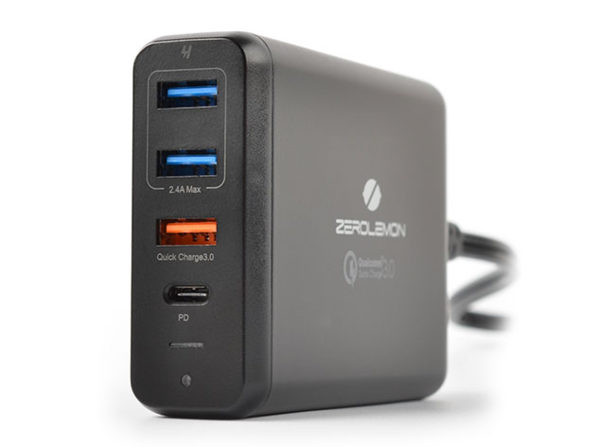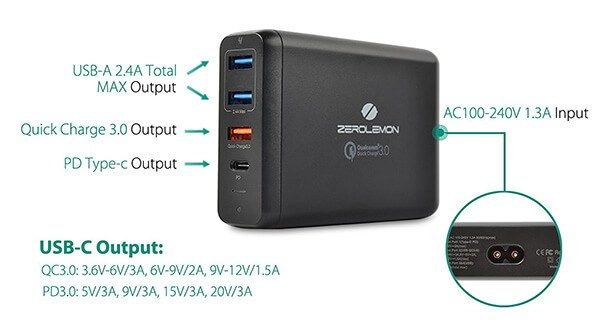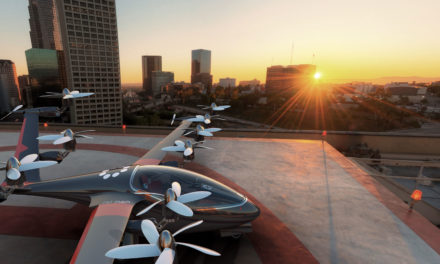As a frequent traveller there are two must have things that I take with me when I travel - a desktop USB charger for my devices for when I'm near mains power, and a portable USB Powerbank for charging my devices on the go.
I've owned a large number of both over the years, in part because I've managed to misplace the odd Powerbank, and secondly due to upgrades as charging technology has evolved, firstly with Qualcomm Quickcharge (QC) standards, and then with USB-C.
I've always been a fan of both Anker and Ravpower portable chargers, and out of all of the devices I've owned and tested I believed they made the best hardware on the market. My loyalty was tested through when I went shopping a few months ago for a new charger for my travel bag.
I currently use a Sony Xperia phone, and have recently upgraded my laptop to a new HP EliteBook G5 which supports USB-C charging. As my existing desktop travel charger didn't support USB-C, I decided it was time to upgrade so I didn't need to carry around a charger for my laptop as well as one for my other devices.
Before I discuss the product further, I'll briefly explain a bit about the USB standards - because things can get a little confusing...
In the early days of the USB standard a USB port supplied a maximum current of around 500mA. A modern phone these days contains a battery that has around 2,500mAh - 3,000mAh capacity, which in layman's terms means it would take around five to six hours to fully charge when plugged into a port supplying 500mA.
As the USB standard evolved current output increased, as did the market for dedicated standalone USB chargers. Many USB chargers will now output 2,100mA (2.1A) or even 2,400mA (2.4A) per port - but just because a device can output up to 2,400mA per port does not mean your device can fully utilitise it. It may draw only a fraction of this current to ensure it doesn't cause damage to the battery when charging.
Several charging standards exist to enable portable devices to charge at the fastest possible rate, the most common of which is Qualcomm's QC standard. Most Android devices built in recent years that use a Qualcomm chipset support the Qualcomm QC2.0, QC3.0 or newer QC4.0 standard.
If I plug my Sony Xperia QC3.0 capable phone into a QC3.0 compatible charger I'll see charging rates up to approximately 2,200mA meaning the device can fully charge in around 80 minutes. I could plug my phone into a regular USB charger that claims 2,400mA output and it probably won't charge any faster than 1,000mA, meaning it will take around three hours to fully charge.
The QC standard negotiates a charge rate between the phone and charger and optimises it to ensure the battery in the device isn't damaged by charging it at rates that it can't support.
It's for this reason that you may find your phone charges quickly if you use the manufacturer suppled charger that comes with the phone, but that it charges a lot slower if you have a cheap replacement charger or Powerbank that doesn't support a quickcharge standard. If you plug your phone into the USB port on back on a plane seat you'll find it charges incredibly slowly because most of these ports can deliver a maximum of 500mA.
The USB-C standard complicates things even further. The USB-C standard has evolved to support a feature known as Power Delivery (PD) that can deliver higher voltage and current than a regular USB-C charger. While a charger that supports USB-C PD is backwards compatible and can charge any USB-C device, a non PD USB-C charger will not charge a laptop or tablet that requires USB-C PD.
USB-C PD chargers typically support 18W, 30W, 45W or 60W PD output. Most laptops require a PD charger than can deliver a minimum of 30W, meaning that some cheaper USB-C PD chargers that can only deliver 18W output may not charge a laptop.
My goal was to find a charger that suppported USB-C PD for my laptop, Qualcomm QC3.0 for my phone, and 1-2 regular USB ports for charging other devices such as my headphones. Little did I realise how difficult this would be!
All my favourite brands such as Anker and Ravpower had chargers that supported USB-C PD or QC3.0, but none that supported both. It was then that I stumbled across the Zero Lemon charger on Amazon.
As several other small brands sell the same charger it would suggest Zero Lemon are only rebranding a generic charger, but as their price was the most competitive I purchased one from them to try it out. The charger can be purchased from Amazon and shipped to New Zealand by Amazon.
The Zero Lemon 75W desktop charger features 2 x 2.4A smart charge USB-A ports, 1 x QC3.0 capable USB-A port, and 1 x USB-C PD port. It supports up to 60W using USB-C PD meaning it can charge modern laptop computers at full speed. Many other brands of USB-C PD chargers only support 30W output meaning charging will take twice as long.
The charger measures 13cm x 2.59cm x 7.01cm and weights in at just over 220g. It does feel solid, and has a nice finish. Along with the USB ports it features an ambient light sensor which will adjust the LED charging light.
All four ports can be used simultaneously, and in my tests charge rates were unaffected using charging my laptop and phone simultaneously.
As I purchased this charger from Amazon in the US it came supplied with a US power cable. As it's a standard figure 8 connector, a NZ cable can be purchased locally for around NZ$5. I typically don't rely on travel adapters when travelling, and instead just take a cable with me for the country I'm visiting.
Charging performance from the device has been great. My HP EliteBook charges at 60W full speed using USB-C PD, and my Sony Xperia shows charge rates of of around 2,000mA using the QC3.0 port. This may be a fraction down on the QC3.0 output of my Anker and Ravpower chargers where I've seen rates slightly faster, but overall the difference in charging time is mimimal when fully charging the phone and comparing chargers side by side.
While I don't own any Apple products, the good news for Apple device owners is that this charger is also perfect for you. The USB-C PD output will allow fast charging of modern MacBook laptops with UCB-C charging support. The iPhone 8, iPhone 8 Plus and iPhone X also support USB-C PD, so if you use this charger and a USB-C to Lightning cable you can charge your phone to 50% capacity in around 30 minutes.
One thing to keep in mind with charging USB-C devices is the type of cable you use. Not all USB cables are created equal, and it's possible for poor quality cables to damage your device. If you're after cables I highly recommend checking out Benson Leung's great resource over at bensonapproved.com where a vast array of cables have been tested by him. I'm a huge fan of braided cables because I find they don't tangle as easily.
Having had this charger for several months now and I honestly believe it's one of the best USB chargers on the market right now. If you're after a great desktop charger with USB-C PD support I highly recommend it.










